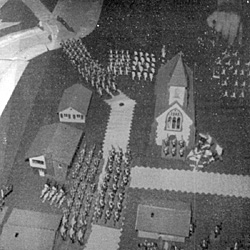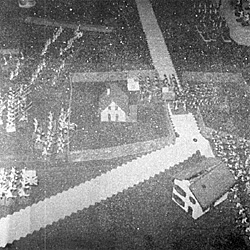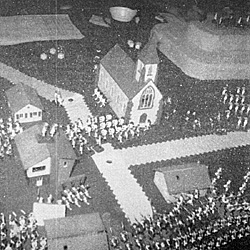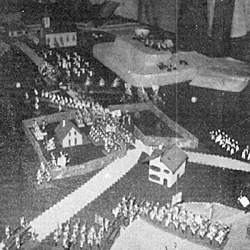 The battle of German Flats was a showdown between the British and the Americans. Both sides had been reinforced and were confident of victory. The American commander, Carl Johnson, and his brigadier (Fob Wall, George Petronis, and Charlie Youngblut) had 6700 infantry 1120 cavalry (both on a 1 to 20 basis), and 5 guns. The British under Ray Mowery (with brigadiers Jerry Hedges, Wayne Knause Dave Ceisz, and Mike Ferguson) numbered 6620 infantry, 580 cavalry, and 6 guns. The American advantage in cavalry and muskets was somewhat offset by the British superiority in elite troops and guns.
The battle of German Flats was a showdown between the British and the Americans. Both sides had been reinforced and were confident of victory. The American commander, Carl Johnson, and his brigadier (Fob Wall, George Petronis, and Charlie Youngblut) had 6700 infantry 1120 cavalry (both on a 1 to 20 basis), and 5 guns. The British under Ray Mowery (with brigadiers Jerry Hedges, Wayne Knause Dave Ceisz, and Mike Ferguson) numbered 6620 infantry, 580 cavalry, and 6 guns. The American advantage in cavalry and muskets was somewhat offset by the British superiority in elite troops and guns.
On the east end of the table, the Americans deployed the Continental Marines, the Delaware Rgt., the Marblehead Rgt., and Dayton's Rgt. backed up by some French troops, Thompson's and Dearborn's Rgts. Advancing through the early morning rain which slowed their progress, they gained the vital crossroad at Willett's Tavern (see photo #2) but desertion to Mr. Willett's bar and its liquid goodies (Mr. Willett is obviously a local Tory!) made the British task easier.
 The British 2nd Division (l8th, 42nd 43rd, and 73rd Rgts.) Plus Johnson's Royal Greens and a battalion of local New Jersey Loyalists tempararily outflanked the Americans and drove them reeling in confused wall to wall fighting around Smith's farm (see photo #. After rallying and being reinforced by their supports, the Americans counter-counter-attacked, and the British fell back, galled by the fire of the light infantry which had worked its way over wooded Wild Cherry Ridge. By nightfall this strategic crossroad (and its strategic tavern) was lost irrevocably to the British who were being pursued down Little Rock Road.
The British 2nd Division (l8th, 42nd 43rd, and 73rd Rgts.) Plus Johnson's Royal Greens and a battalion of local New Jersey Loyalists tempararily outflanked the Americans and drove them reeling in confused wall to wall fighting around Smith's farm (see photo #. After rallying and being reinforced by their supports, the Americans counter-counter-attacked, and the British fell back, galled by the fire of the light infantry which had worked its way over wooded Wild Cherry Ridge. By nightfall this strategic crossroad (and its strategic tavern) was lost irrevocably to the British who were being pursued down Little Rock Road.
Meanwhile, in the center, the skillfully handled, but desperately outnumbered British Light Dragoons (16th and 17th) managed by a series of feints to hold the massive American cavalry arm at bay and even to inflict heavy losses.
 Eventually, however, superior weight told and the shattered remnants of the dragoons fled the field.
Eventually, however, superior weight told and the shattered remnants of the dragoons fled the field.
On the crucial west end of the field, where the British had decided to make their major push, the Hessians (AltLossberg, Prinz Carl, and some grenadiers and jagers) won the foot race into German Flats (see photo #1) and occupied three of the four houses and the vital church. The tardiness of Brigadier Knause with the reinforcements (3rd, 5th, 23rd Rgts.) caused by a narrow bridge enabled the Americans (1st Ga., 2nd Canadian, Haslet's. and Sherburne Rgts, plus the 3rd N.J.) to capture the church by a fierce onslaught. The Germans regrouped and steamrollered back through the village, backed by the British light infantry and grenadiers (see photo #3).
 At this point, the Hessians and British, although in firm control of the village of German Flats, were too exhausted to pursue the Americans over Ox Tail Creek. A half-hearted attempt to capture the American battery on Bald Hill by the British light infantry was bloodily repulsed by Morgan's riflemen shortly before nightfall.
At this point, the Hessians and British, although in firm control of the village of German Flats, were too exhausted to pursue the Americans over Ox Tail Creek. A half-hearted attempt to capture the American battery on Bald Hill by the British light infantry was bloodily repulsed by Morgan's riflemen shortly before nightfall.
With the rout of their cavalry and the loss of the eastern crossroads, General Mowery ordered a general retreat of all British and Hessian forces toward the south under cover of darkness. At the next day's dawning, the Americans, deceived by fires left burning in German Flats, discovered that the redcoats had eluded their grasp, at least for the time being.
Back to The Armchair General Vol. 2 No. 3 Table of Contents
Back to The Armchair General List of Issues
Back to MagWeb Master Magazine List
© Copyright 1969 by Pat Condray
This article appears in MagWeb (Magazine Web) on the Internet World Wide Web. Other military history articles and gaming articles are available at http://www.magweb.com
